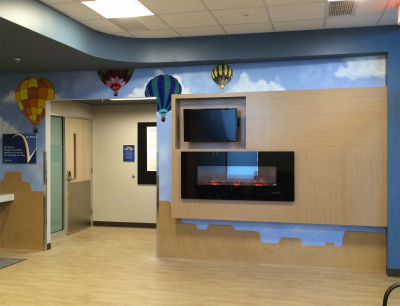
Each fall, New Mexico residents wait in anticipation for the Albuquerque International Balloon Festival, one of the largest festivals of its kind across the world. Large, radiant balloons paint the sky, inspiring a sense of awe that lives only in imaginations for the rest of the year. But thanks to a local artist by the name of Andrew Dennis, patients at DaVita Del Norte Dialysis in New Mexico are greeted by these colorful balloons each day they walk into the center for dialysis treatment.
For the last decade, DaVita has been reimagining how the health care industry builds dialysis centers like Del Norte. More than half a million Americans in kidney failure rely on dialysis to live. For those people, treatment isn’t optional – it’s life sustaining. Most of these patients receive treatment in a dialysis center for four hours a day, three days a week. Their care teams become like a second family, and the dialysis center, like a home away from home.
“The reality is, so many medical centers feel cold and sterile,” says Patrick Noble, director of design at DaVita. “To create a sense of comfort and connection, we decided to reimagine the typical outpatient treatment center with familiar details that make it feel like part of our patients’ community.”
To do this, DaVita started the tradition of a regional wall. As patients enter the center, they are greeted by an accent wall that pays homage to the culture of the region. At Del Norte, mosaic glass tiles pieced together by Dennis to replicate the balloon-spotted sky its patients have seen every October – many from the time they were children.
“Mexican, Native American and Southwest art kind of meld together and [the style] is unique to our state and our area,” says Del Norte facility administrator, Matt Wert, when discussing how the mural’s design speaks to Albuquerque’s culture. “It’s our heritage, culture…it’s basically a sense of identity.”
Wert believes that this wall gives his patients a sense of home, allowing them to dwell on special memories that span generations, rather than the cold feeling of a medical facility.
Although most companies build against a single prototype across the country, DaVita partners with construction crews to build treatment centers to match the look and feel of the community. At Del Norte, the outside walls’ varying shades of tan and brown match the local, desert landscape. While on the East Coast, a DaVita center may be built with brick to blend in among old brownstones.
Localizing the design of each dialysis center creates a need to hire local tradesmen, carpenters and other craft workers with experience in the area’s native materials. Ultimately, this has led to increasing the investment in a given community well before the first patient walks through the doors.
“We believe that our centers should be an extension of the communities our care teams are part of,” says Noble. “This extends beyond the way a building looks to the way it supports the economic and environmental health of the center’s patients and teammates.”
While dialysis is so critical to those who need it, it’s also taxing on the environment. In fact, each of the nearly 2 million treatments given each year in the U.S. exhausts over 3.5 billion gallons of water and 766,000 MWh electricity.
Back in 2010, DaVita built the first Leadership in Energy and Environmental Design (LEED) certified dialysis center. Since then, the health care provider has worked to refine its blueprint and can now build a “green” dialysis center virtually anywhere in the U.S.
This design includes low volatile organic compound paint, vinyl flooring – eliminating the need for floor wax – LED lighting, rather than fluorescent, and building management systems to control the energy use within dialysis centers.
Today, each new DaVita dialysis center that opens its doors nationwide is built to meet or exceed LEED silver standards – a mission included in DaVita’s 2020 environmental goals.
In reflecting on why the health care company has prioritized sustainable operations, Noble cited record-breaking wildfire seasons recently experienced by DaVita’s home state of Colorado, along with states along the West Coast. Catastrophes like these, which leave behind long-lasting environmental impacts, are one reason why DaVita has embedded sustainability into the fabric of the company.
“Our dedication to helping protect the environment is grounded in a belief that DaVita is a community first, a company second,” said Noble. “We care for each other and our world with the same intensity for which we care for our patients.”
DaVita Del Norte Dialysis is only one example of DaVita’s green building prototype intended to positively impact a patient’s treating environment and the physical environment. DaVita centers across the country are built with the same goal in mind, including its business offices.
Reportedly, DaVita recently became the first U.S. dialysis company to commit to using 100% renewable energy, opening a new chapter in its sustainability journey.
Visit DaVita.com/CSR for more information on DaVita's commitment to the communities it serves.









